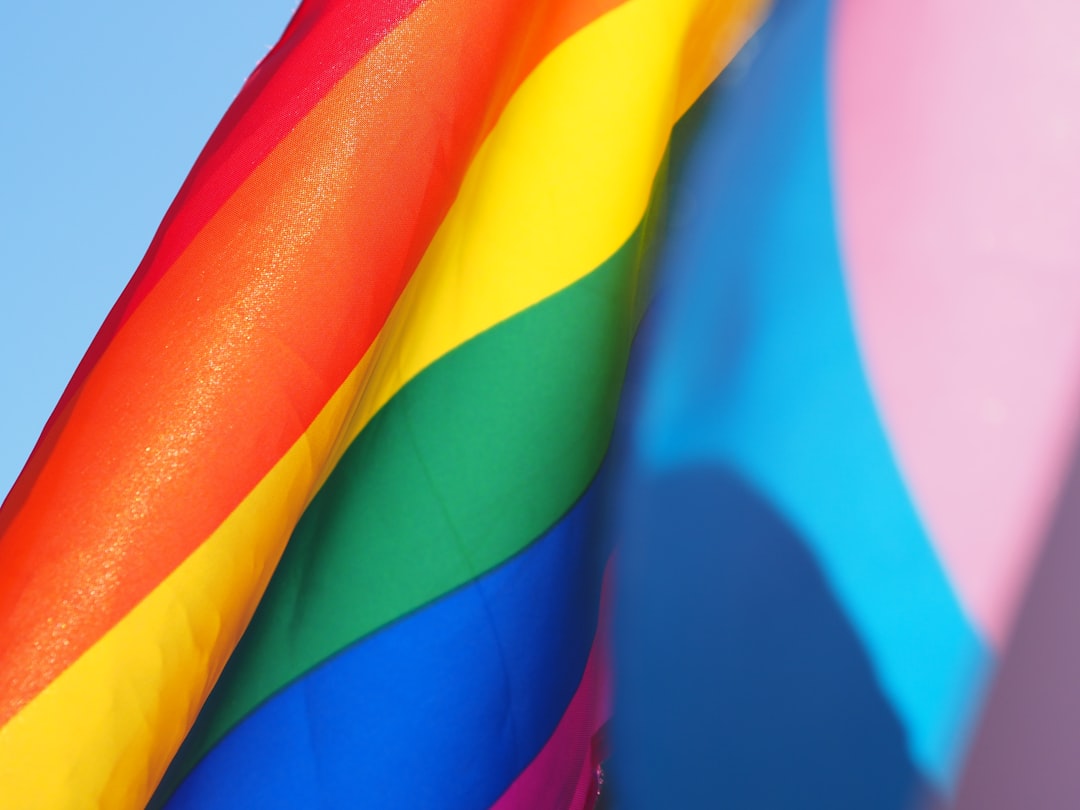How to write about trans people with respect
A guide to help you support and attract LGBTQ+ readers
Hi friends,
I’m a newer reader of
and their work at , but even before I subscribed I knew I wanted them to write a piece for The Author Stack. Their work is so important to the author community, which only grows my learning from and being understanding of as many lived experiences as possible.I learned a lot from this piece. I like to think that learning to be a more inclusive human is an important part of my journey. I am a het, cis, white man in America, and I’ve spent years breaking through all the privilege that comes with those identities.
For instance, while sourcing images for this article, I realized it’s nearly impossible to find trans or nonbinary models, or even depictions of same-sex relationships that didn’t revolve around either pride flags or pride marches.
When I brought it up with Rey, they told me that it was not just a problem with Substack, which simply connects to Unsplash for their stock photos. A similar problem exists on Pexels and Pixabay.
“For my website,” Rey told me. “I sometimes just put a photo of some diverse group of people, who may or may not be trans. I think that works because there isn't necessarily a specific "look" to trans people.”
The work of breaking down your conscious and unconscious biases is the work of a lifetime. I’ve been at it for decades and I fail all the time. Often, I feel like a terrible person for failing to live up to that ideal, but I try very hard to live up to the standards Rey lays out in this article.
For my small part, you probably have not noticed, but I strive to keep The Author Stack a gender-neutral publication where they/them pronouns are the default.
Enough about me, though. This is about highlighting Rey’s work. If you haven’t read anything from them, I recommend this piece.
Trans people are experts in any given field and valued members of our families and communities, yet we are underrepresented (and badly presented) in journalism, books, and media. Around 1.2 million American adults are nonbinary1, according to a 2021 study. Respectfully writing about trans and nonbinary people is a crucial prerequisite for connecting with an audience of LGBTQ+ people and allies.
Perhaps you are writing a trans character in your novel, including a trans family member in your memoir, or interviewing a trans expert for your piece. This guide will help you successfully translate your good intentions into a positive impact on your readers.
Every trans person is different. I cannot speak for the trans community to tell you exactly what words to use. The best way to know how to describe a specific person is to ask them (or perhaps to check their website or social media bio). Just like confirming the spelling of someone’s name or their job title, it only takes a little more effort to double-check how people refer to themselves in terms of their gender. This one small step can make a huge difference.
Who am I and why is writing about trans people respectfully important to me?
Hi, I’m Rey Katz. I’m a queer, nonbinary, transmasculine person who uses they/them pronouns. A quick definition of some of those terms: queer refers to my sexuality2, and I’m interested in people of various genders. Nonbinary3 means I am not a man or a woman. Transmasculine4 means I am transitioning in the masculine direction, that I am more male than female, but am not a man, otherwise I might have said “trans man.”
I came out as bisexual at age 18 and as a nonbinary person around age 28. I’m 33 now. Writing about my experience of gender helped me understand and express myself, which greatly improved my mental health and confidence.
People misgender me as female often. Sometimes that feels painful to me, like getting a stomach ache or heartburn (when people I’ve known for years try to convince me I’m a woman), and sometimes I just feel resigned (when a customer service representative calls me “ma’am” every ten seconds).
I cannot control how the world thinks about me (nor do I wish to). It’s important for me to refer to myself using respectful language affirming my gender identity. But when people ask me how they can correctly refer to me, I appreciate the question, and I have some suggestions.
I write about what it feels like to be nonbinary in my newsletter, Amplify Respect. I also interviewed eight trans experts to create a guide for journalists writing about trans people with respect. For Catapult, I wrote a craft essay about writing nonbinary characters. And for Brevity’s Nonfiction Blog, I wrote how to include nonbinary people in creative nonfiction.

What is the difference between trans, nonbinary, and agender?
Trans5 means having a gender different from your gender assigned at birth. For example, a woman who was assigned male at birth might describe herself as a trans woman. The space between “trans” and “woman” is because “trans” is a modifier for woman, just like “short,” “Canadian,” “artistic,” or any of the other adjectives we use to describe people.
Cisgender6 means not-trans. So if you’re not a trans person, if you identify with the gender you were assigned at birth, you’re a cis person. Cis is not derogatory and is not a slur. It is merely a description.
Nonbinary7 means not entirely a woman or a man. Genderqueer8 means not following binary gender norms.
Agender9 means not male or female, not identifying with any specific gender or experiencing a lack of gender. (That’s different from “asexual”10 which means not sexually attracted to anyone.
You can’t tell someone’s gender by their appearance, voice, name, or other traits. If you need to write about someone’s gender, ask them (or check their website or social media bio) for the correct wording.

What are misgendering and deadnaming?
Misgendering11 is referring to someone as a gender they are not. For example, referring to a woman as a man is misgendering. Calling her “him,” “sir,” “Mr.,” or titles such as “son” or “congressman,” is also misgendering. While misgendering can happen by mistake, it can feel incredibly painful. Trans people may have to deal with misgendering for decades, every conversation with a stranger reminding them they are not seen as their true self. So it’s not just your one-time mistake they are feeling: it’s the compounded emotions from a lifetime of harsh comments. Ask or check what gendered words are appropriate before writing about someone, to avoid causing hurt, even if unintentionally.
Deadnaming12 is using someone’s previous name to refer to them instead of their correct, current name. Some trans people refer to their previous name as their “dead name” to indicate that identity is dead to them, and to indicate their level of negative feelings when hearing or reading that name. Don’t include a trans person’s old name when writing about them. You don’t need to write about the birth name of Freddie Mercury, Muhammad Ali, or Elliot Page—and you don’t need to mention the birth name of another person you’re writing about either.
If you’re talking about a real person in the past when they had a different name and pronouns, I encourage you to use their current name and pronouns. It’s just more respectful. Imagine that person reading your piece. Wouldn’t they prefer to see their correct, current name?
If you are writing a fictional character, it’s possible to have them change name and/or pronouns during your narrative, for example, the character decides to change their name and asks the other characters to refer to them by their new name, as part of the story.

What words for trans people are disrespectful and how can we do better?
Anti-trans rhetoric has sadly made it into mainstream media13, so be careful not to use offensive phrases, even if you commonly hear them from others. I’ll list some offensive phrases here with suggested replacements.
“Transsexual” or “transvestite”14: outdated terms that can be offensive. Use “trans” or “transgender” instead. You can also say “trans man,” “trans woman,” or “trans person” as relevant.
“Transgenderism”: While this is often referred to by conservatives, being trans is not a belief system and this is not a real word.
“A transgender” or “transgendered”: Grammatically incorrect, often used for offensive effect. Use just “transgender,” for example, “she is transgender.”
“Born female” or “born male”: Use “transfeminine” or “transmasculine” to indicate the direction the person is transitioning. Another option is “assigned female at birth” or “assigned male at birth.”
“Biological female” or “biological male”: Just, no. Biology is complicated and this wording is transphobic. Chances are the rest of your sentence has fallen into harmful stereotypes and could be removed.
“Identifies as a they them” or “Rey is a they”: People are not their pronouns. Use “Rey is a nonbinary person” or “Rey (they/them).”
“Preferred pronouns”: Use just “pronouns.” Folks were calling them preferred pronouns for a minute, but we don’t want to imply people’s pronouns are optional or just a mild preference.
“Identifies as”: Use “is.” If you say “she identifies as a woman,” it sounds like you are skeptical whether this person really is a woman. Much clearer and more respectful to say “she is a woman.”
“Women and women-identifying”: While this is a well-meaning attempt to be inclusive (I think), I literally have no idea what this means. Can we just say “women” please? Note that “women” includes both cis and trans women by definition.
“Both genders”: Use “all genders.” “Various genders” is another inclusive phrase.
“Testosterone-fueled rage/acting hormonally/etc”: Usually, these phrases can be replaced by talking about toxic masculinity. Most unhealthy masculine behavior and derision towards expressing emotions comes from how we were raised in a patriarchal society. It’s not really about hormones.
“Did you get the surgery?”: Gender-affirming health care covers a whole range from supportive talk therapy to gender-affirming hormone therapy to a wide variety of surgeries. It’s offensive and intrusive to assume trans people are interested in or can access one particular procedure.

When is it okay to talk about trans people’s medical history or body parts?
Never. Okay, almost never. I worked for a healthcare company for three years and learned not only is it illegal to share personal health information without consent15, it can be damaging to a patient’s personal and work life to have that private information leaked.
Treat trans people’s medical history like anyone else’s: don’t share personal health information that’s not public without consent. This includes surgeries, medications, and test results.
If you’re writing about a medical procedure, ask yourself, would I describe this the same way if a person who is not trans is getting this procedure? (Most gender-affirming medical treatments were developed for cis people. Cis people commonly get breast reductions, implants, facial feminization surgery, laser or electrolysis to remove hair, and take hormone replacement therapy.) Gender-affirming health care is just health care.
Write about medical procedures in a calm, matter-of-fact way, avoiding graphic or dramatized depictions. Don’t write about people’s bodies for shock value, don’t ask about their genitals (how rude!), and don’t make people’s hormones more important than who they are.

How do I use “they” for a single person?
“They”16 can be used instead of a person’s name. You can say “Rey is over there. That’s Rey’s bag.” Or equivalently, you can say, “They are over there. That’s their bag.”
Your intuition for how to speak is powerful. If you’re complaining about an unknown person, you likely already know how to use “they” and “them.” You might say without thinking, “I can’t believe they put pineapple on my pizza and they charged me too much.”
If a phrase sounds wrong, it’s probably wrong. Don’t say: “Rey are over there. That’s they’s bag. They is tired of seeing ‘they’s’ which should be ‘their.’” Trust your intuition. Don’t make it more complicated than it has to be.
For some folks, it’s hard to start using “they” and “them” for a person they know and like. There’s a connotation that “they” can be used for the stranger who messed up your order or the client who ruined your day or the woman you say you’re not dating. You may have to practice saying “they” for someone you love, without feeling you are distancing yourself from that person.
Some people use pronouns other than they/them, he/him, or she/her. These are called neopronouns17. Neopronouns include: xe/xem/xyr, ze/hir/hirs, ey/em/eir, fae/faer/faers, per/per/pers (like “person”), as well as other sets of pronouns. Here’s an example: “That’s faer bag. Fae forgot to take it.” Another example: “Ze forgot hir bag.” Practice will help you become more comfortable speaking with neopronouns. In writing, it’s a good idea to double-check your work to ensure the pronouns are correct.
I love the phrase “morally neutral” which I learned from KC Davis, author of How to Keep House While Drowning. A person’s gender and the words they use to describe themselves are morally neutral. It’s not better for someone to call himself “he” instead of “they” or vice versa. It’s not better for someone to be a woman instead of being nonbinary. People simply are who they are.

What does being trans or nonbinary mean about who you are attracted to or who is attracted to you?
“Trans” and “nonbinary” describe a person’s gender, saying nothing about who that person is attracted to. This is the same as “man” or “woman”—you don’t know a person’s preferences based on their gender.
When writing about trans people, avoid tropes: it’s harmful and wrong to assume trans people are undesirable or fetishized. Trans people can be gay, straight, bisexual, asexual, etc. When a trans person comes out to their partner in a relationship, sometimes that relationship ends, but sometimes that relationship grows stronger.
When you’re writing about your own relationship with a trans person, it may be tempting to blame their transness for causing problems. That’s almost always a surface-level view, though. Communication, honesty, trust, openness, and willingness to learn and change (or the lack of these traits) influence relationships far more. If you need to talk about the pain points in your relationship with a trans person, that’s your right to share your story. But please make it about the communication or other difficulties, without blaming anyone for being trans.

What are the best practices for writing about my trans relative?
As writers, we frequently struggle with what to share and what to keep private. If a family member is trans, that adds another level of difficulty.
Consider your family member’s safety. Are they out to their entire community and their workplace, or are they “stealth” or closeted? Sharing anyone’s trans identity publicly could be extremely damaging if they aren’t out. You could try to obfuscate who you are describing in your piece, but do you want to risk that secret getting out?
Can you write the story you want to tell without mentioning your family member is trans?
If it is crucial to you to tell the story of your family member’s transness, can you ask them what they are okay with you sharing? I realize this may be impossible or impractical, such as with a relative who passed away or an ex you are not speaking to.
I encourage you to write about your trans relative using the name, pronouns, and gendered descriptions you would use today for them. Let the reader know this character is trans right away if you are going to share that information. Transness is not a good plot twist.
Trans people are not your plot twist and not your jump scare
As writers, we turn mundane daily life into exciting stories all the time. But stay far away from a damaging trope found in many movies and TV shows: It's hurtful when a character is suddenly revealed to be trans, and other characters react in shock and disgust I highly recommend watching the excellent documentary Disclosure on Netflix which demonstrates many examples of transphobic tropes with commentary by trans experts. It’s so hurtful to see your existence summed up as a joke, used for a jump scare, or to watch horrified reactions over and over.
So don’t write about trans people as they are depicted in the movies of our childhood. Write about a real, actual person or a character inspired by reality. Don’t build suspense, confusion, and don’t have a big reveal. A person’s gender is not a good plot twist.

If I write a nonbinary character in my novel, is that appropriate or appropriation?
An aspiring author asked me if having a nonbinary dragon in his novel sounded okay. He was concerned that making the nonbinary character non-human would be othering.
After hearing the details of the character, I actually thought it was pretty neat to have a nonbinary dragon, as the description seemed respectful and interesting. After all, what makes a dragon more likely to be male or female instead of nonbinary?
If you’re not trans or nonbinary yourself, I’d recommend not making your novel primarily about a character’s transness, and consider not making the main character trans.
Consult with trans and nonbinary people while you are developing your character and consider paying a sensitivity reader. Be open to feedback and willing to rewrite.
Well-written trans and nonbinary characters are enjoyable to read and provide great supportive representation for our community.

Should my fictional trans character be accepted by their community?
As a kid growing up in rural New Jersey, I read almost every YA novel our library stocked. The only character who was even a little bit trans was Alanna in Tamora Pierce’s Song of the Lioness series. Alanna was a fictional girl who lived as a boy for years. Even though Pierce emphasizes frequently that Alanna really is a girl, as often as 3 times in a single page, this story spoke to me in a way I could not understand yet.
As an adult, I love reading YA novels with trans and nonbinary characters. Some of my favorites are Once & Future by Cory McCarthy and A.R. Capetta, The Black Tides of Heaven by Neon Yang, Light From Uncommon Stars by Ryka Aoki, and A Psalm for the Wild-Built by Becky Chambers. These books help me heal my inner child, who’s still wandering the stacks of the local library, wondering who I am and what’s wrong with me.
This is why I prefer books in which trans characters are loved, accepted, and supported. I like losing myself in a magical realm where being trans is not a big deal and trans people are just like anyone else.
Many people’s reality of struggling due to our transphobic society can also be an important story to share. Perhaps that is your story to tell if you have experienced transphobia personally, but if you are not trans, I recommend leaning into stories of acceptance.

How can I make my marketing, business, and community more gender inclusive?
The most simple answer I have for this fairly involved question is: make everything gender-neutral. That doesn’t mean you can’t speak about gender or marginalized categories. Please talk about feminist values, support for women, support for trans people, and anti-racism. But when you describe your audience or community, if you use gender-neutral terms, you will likely appeal to more people.
The Author Ecosystems by Monica Leonelle and Russell Nohelty is a great example of a gender-neutral framework. After taking the quiz, I found I’m a Forest! The insights into my writing and marketing strategy helped me focus and grow my Substack, and I felt good about that knowledge in part because a Forest, Desert, Grassland, etc, is a gender-neutral idea, just as relevant for a woman, a man, or a nonbinary person.

What do trans people need to watch out for when writing about other trans people?
Everyone has their own perspective and experiences. It’s important to remember that the trans community is incredibly diverse and hard to generalize. In particular, if you’re transmasculine, be very careful about writing about the transfeminine experience, and vice versa. Consider quoting experts with attribution rather than relying on your own experience.
Ask yourself: am I talking about people with a different gender experience than myself? Am I generalizing? Can I talk about my own experience instead? Do I need to ask a friend or hire a sensitivity reader from the demographic I’m talking about?

How can I learn more about speaking and writing about trans people with respect?
There are many excellent books by trans authors sharing their experience. If I had to pick just one to recommend, it would be He/She/They: How We Talk About Gender and Why It Matters by Schuyler Bailar. Bailar shares life-changing stories, hope, inspiration, and addresses difficult questions about being trans with empathy and kindness.
If you are a journalist or write cultural criticism, please check out the Trans Journalists Association Stylebook and Coverage Guide.
Thank you so much for reading about how to write about trans people with respect!
Positive, accurate trans representation is so important. Being able to advocate for LGBTQ+ rights as an author is crucial to gaining the support of our community.
Please let me know what you think in the comments. I’d also love to see you over at Amplify Respect, our community for trans and nonbinary people and allies!
If you enjoyed that one, I highly suggest you check out Rey’s work. If you haven’t read anything of theirs yet, try this one.
I’m constantly on the search for new, interesting points of view to help authors grow, not only their income, but their perspectives. The more perspectives you can learn, the better your writing will become. People ask me why I consume so much media, but I think it’s the table stakes to do this work, and a big part of it is learning about other lived experiences. It makes you a better writer and a better human.
If you want to see more of these types of articles, let me know in the comments. Please note, if you’re a hate-filled bigot in the comments, I will block you. If you are a paying member, I will refund you and ban you from my publication forever. I always expect you to be kind in the comments, but this time I demand it.
It takes a lot of time to find interesting voices and work with them to bring articles to you. If you like what I’m doing here, maybe consider becoming a paid member. You get access to over a dozen novels, comics, and non-fiction books, and you can start with a free 7-day trial, or give us a one-time tip.








Thank you so much, Russell, for publishing my article and for your great editing, collaboration, and insight! I'm incredibly excited to share all these great resources with everyone.
Thanks Rey (& Russell for hosting) - I'm still learning, and appreciate your clear & comprehensive sharing. My mum is managing my spouse's pronouns (they/them) very well at nearly 80 - if she can do it, no excuses for me or anyone else 🙂